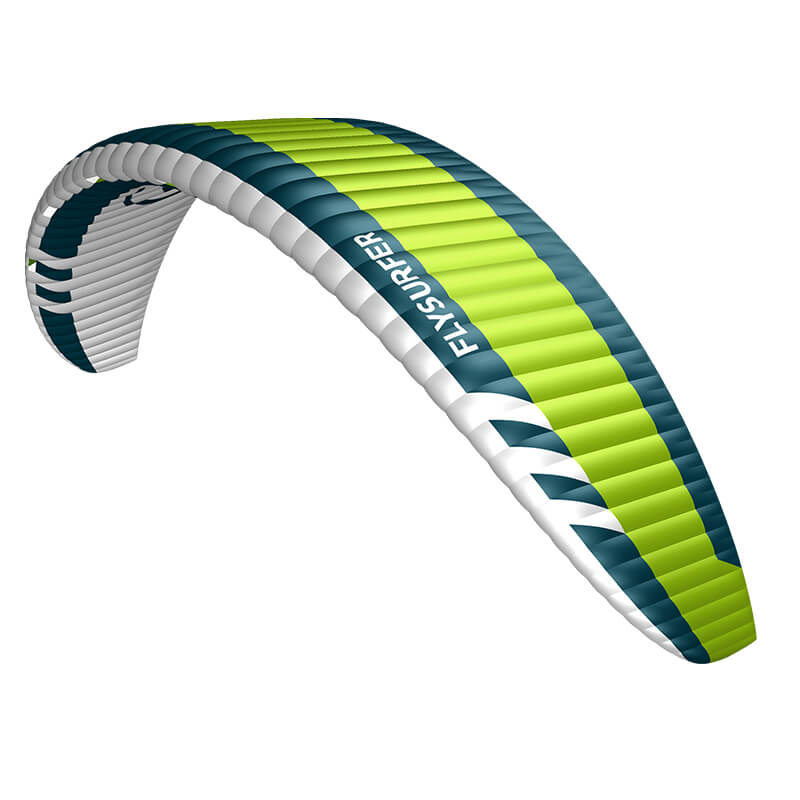When you purchase gear through links on our site, we may earn a small commission. Here’s why you can trust our tests and our affiliate partner.

German soft kite aficionados Flysurfer have been in the foil game since its inception, and the Sonic has always set a benchmark for high-end performance kites that you don’t need to pump up. From a development perspective, the third version Sonic has DNA from the full race VMG model as design basis, but lowering the aspect ratio, rounding the wing tips and adding a bridle layer to make it more user friendly. It is worth noting the aspect ratio is tailored to each size increment, with the number diminishing on smaller sizes.
From a build perspective, there are a lot of cells there. It is certainly a product that has been designed to an incredible technical specification. The trailing edge benefits from double cells across its entire span. The leading edge has curved plastic battens to keep the profile tidy up front. The internal construction makes it very rigid in the airframe for such a high-aspect soft kite. A single deflation valve does its job well, and the bridling is very low diameter, minimizing drag. It features the same fabric construction as the SOUL, with a mixture of X-lite and DLX cloth in areas prone to abrasion.
Off the mark, an updated internal structure means inflation and launch is easier than ever in light wind, with a quick tug of the front lines and some steering line pressure on climb the Sonic takes its shape very quickly. There’s no frantic sheeting of the bar required to get those pesky wingtips inflated. Turning has that classic high aspect foil ability to stall in the middle of the window and put it into a flat spin, which is mighty useful in lighter wind to boost you up on to a hydrofoil where the higher aspect means there is less initial grunt.
With a twintip, it lends itself to old school big air, providing high lofty jumps and gentle descents and enough time and float to let you grab and put in as many multiple rotations as you desire. It has definitely got a lot more height potential than the SOUL. A higher aspect and thinner profile provide a killer upwind performance and rapid forward flying speed. For sure I’m comparing apples and pears, but normal turning speed is fairly similar to the SOUL – the key difference is the ability to stall turn it and skid the back end out around the corners like a rally car.
Water relaunch is often the Achilles heel of the soft kite, but considering its performance the Sonic does an admirable job. A two-line reverse launch seems the most safe and reliable method. Winch it up a few meters off the water and use the pivot turn to get it back up the window. The wing tip drains do their job noticeably well here.
For the uninitiated, there are a few caveats to all this performance with regards to flying technique. You need to be wary to keep rear line pressure on constantly and not sheet out too suddenly to keep the tips inflated, plus keep an eye on the overflying tendency when it is gusty as it flies so far into the window.
The Infinity bar has had a good working over and now sports some decent molded EVA floats on the steering line. The front-line flag system runs approximately three quarters of the way up to the kite and flanks one of the front lines. There is a lower auto-untangling system with two PU-covered depower lines running through a dual aperture bar insert. These are typically elegant narrow diameter and low friction.
If you are coming from an LEI background, it is going to take a little time and technique adjustment to learn what conditions it suits and fully trust the kite, but once faith is instilled you unlock a generous dollop of rewarding performance, the key being to keep the back lines tight at all times.
In a sentence: Flysurfer have done a great job with the new Sonic, it is spicy enough to keep the die-hard foil flyers interested, but is now accessible enough to also captivate even those with minimal foil kite experience.
